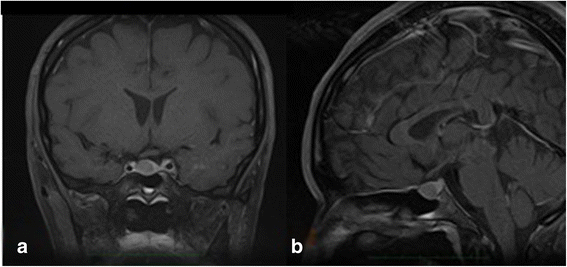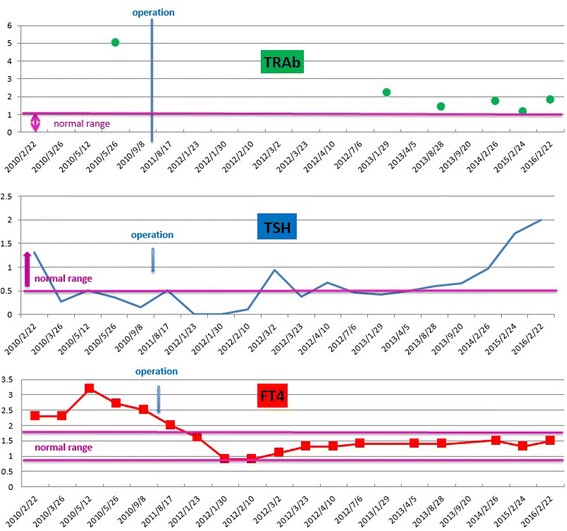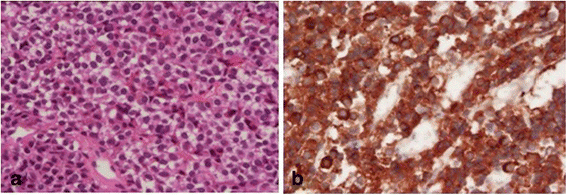Thyrotropin-producing pituitary adenoma simultaneously existing with Graves' disease: a case report
- PMID: 28061802
- PMCID: PMC5217335
- DOI: 10.1186/s13256-016-1172-4
Thyrotropin-producing pituitary adenoma simultaneously existing with Graves' disease: a case report
Abstract
Background: Thyrotropin-producing pituitary tumor is relatively rare. In particular, concurrent cases associated with Graves' disease are extremely rare and only nine cases have been reported so far. We describe a case of a thyrotropin-producing pituitary adenoma concomitant with Graves' disease, which was successfully treated.
Case presentation: A 40-year-old Japanese woman presented with mild signs of hyperthyroidism. She had positive anti-thyroid-stimulating hormone receptor antibody, anti-thyroglobulin antibody, and anti-thyroid peroxidase antibody. Her levels of serum thyroid-stimulating hormone, which ranged from low to normal in the presence of high levels of serum free thyroid hormones, were considered to be close to a state of syndrome of inappropriate secretion of thyroid-stimulating hormone. Magnetic resonance imaging showed a macropituitary tumor. The coexistence of thyrotropin-producing pituitary adenoma and Graves' disease was suspected. Initial therapy included anti-thyroid medication, which was immediately discontinued due to worsening symptoms. Subsequently, surgical therapy for the pituitary tumor was conducted, and her levels of free thyroid hormones, including the thyroid-stimulating hormone, became normal. On postoperative examination, her anti-thyroid-stimulating hormone receptor antibody levels decreased, and the anti-thyroglobulin antibody became negative. The coexistence of thyrotropin-producing pituitary adenoma and Graves' disease is rarely reported. The diagnosis of this condition is complicated, and the appropriate treatment strategy has not been clearly established.
Conclusions: This case suggests that physicians should consider the coexistence of thyrotropin-producing pituitary adenoma with Graves' disease in cases in which thyroid-stimulating hormone values range from low to normal in the presence of thyrotoxicosis, and the surgical treatment of thyrotropin-producing pituitary adenoma could be the first-line therapy in patients with both thyrotropin-producing pituitary adenoma and Graves' disease.
Keywords: Endoscopy; Graves’ disease; Neurosurgery; Pituitary neoplasms; TSH-producing tumor; TSHoma; Thyrotropin.
Figures



Similar articles
-
Concurrent Graves' Disease and TSH Secreting Pituitary Adenoma Presenting Suppressed Thyrotropin Levels: A Case Report and Review of the Literature.Front Endocrinol (Lausanne). 2020 Aug 6;11:523. doi: 10.3389/fendo.2020.00523. eCollection 2020. Front Endocrinol (Lausanne). 2020. PMID: 32849306 Free PMC article. Review.
-
A remarkable case of thyrotoxicosis initially caused by graves' disease followed by a probable TSHoma - a case report.BMC Endocr Disord. 2020 Aug 27;20(1):133. doi: 10.1186/s12902-020-00611-7. BMC Endocr Disord. 2020. PMID: 32854689 Free PMC article.
-
Graves' disease coexisted with resistance to thyroid hormone: a case report.J Med Case Rep. 2021 Sep 25;15(1):473. doi: 10.1186/s13256-021-03061-4. J Med Case Rep. 2021. PMID: 34560890 Free PMC article.
-
[Basedow's disease and thyroid stimulating hormone producing pituitary adenoma in a patient].Ugeskr Laeger. 1991 Mar 18;153(12):854-5. Ugeskr Laeger. 1991. PMID: 2014575 Danish.
-
A thyrotropin-secreting macroadenoma with positive growth hormone and prolactin immunostaining: A case report and literature review.Niger J Clin Pract. 2015 Sep-Oct;18(5):693-7. doi: 10.4103/1119-3077.158983. Niger J Clin Pract. 2015. PMID: 26096253 Review.
Cited by
-
A Collision Tumor of Pit-1/SF-1-positive Double Pituitary Adenoma and a Craniopharyngioma Coexisting with Graves' Disease.NMC Case Rep J. 2023 Jun 6;10:169-175. doi: 10.2176/jns-nmc.2022-0396. eCollection 2023. NMC Case Rep J. 2023. PMID: 37398916 Free PMC article.
-
Concurrent Graves' Disease and TSH Secreting Pituitary Adenoma Presenting Suppressed Thyrotropin Levels: A Case Report and Review of the Literature.Front Endocrinol (Lausanne). 2020 Aug 6;11:523. doi: 10.3389/fendo.2020.00523. eCollection 2020. Front Endocrinol (Lausanne). 2020. PMID: 32849306 Free PMC article. Review.
-
Central hyperthyroidism combined with Graves' disease: case series and review of the literature.Eur Thyroid J. 2023 Jul 28;12(4):e220223. doi: 10.1530/ETJ-22-0223. Eur Thyroid J. 2023. PMID: 37602950 Free PMC article. Review.
-
Clinical characteristics and outcomes of patients with TSH-secreting pituitary adenoma and Graves' disease - a case report and systematic review.Thyroid Res. 2024 Feb 5;17(1):3. doi: 10.1186/s13044-023-00184-2. Thyroid Res. 2024. PMID: 38311752 Free PMC article.
-
Mixed thyrotropin-secreting pituitary neuroendocrine tumor coexisting with Graves' disease: a case report.Front Med (Lausanne). 2024 Sep 4;11:1436400. doi: 10.3389/fmed.2024.1436400. eCollection 2024. Front Med (Lausanne). 2024. PMID: 39296905 Free PMC article.
References
-
- Azukizawa M, Morimoto S, Miyai K, Miki T, Yabu Y, Amino N, et al. TSH-producing pituitary adenoma associated with Graves’ disease. In: Stockigt JR, Nagataki S, et al., editors. Thyroid Research. Canberra: Australian Academy of Science; 1980. pp. 645–8.
Publication types
MeSH terms
Substances
LinkOut - more resources
Full Text Sources
Other Literature Sources
Medical

